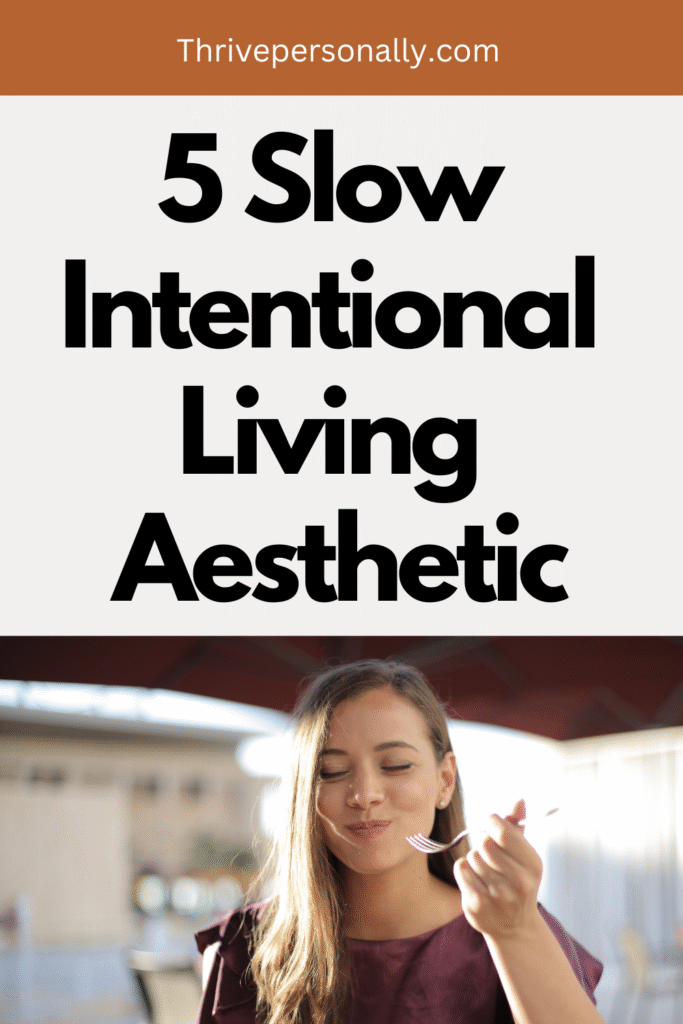Modern life moves fast. You wake up, rush through your day, check your phone every few minutes, jump from one task to another, and go to bed feeling tired, distracted, or unfulfilled. Even when you’re doing nothing, your mind keeps racing. This constant busyness leaves little room to enjoy the moment, breathe, or feel truly present.
Over time, you may start to wonder if there’s a better way.
That’s where slow and intentional living comes in.
What Is Slow Intentional Living?
Slow intentional living means choosing to move at your own pace. It’s not about being lazy or avoiding effort. It’s about removing distractions, slowing your mind, and making space for what truly matters.
This way of living asks you to become more thoughtful. You become aware of how you spend your time, what you consume, and how you respond to the world around you. It’s about living with clarity and presence.
The Aesthetic of Slow Living
The slow living aesthetic is more than cozy rooms or soft lighting. It’s the feeling behind those things—the calm, the sense of connection, the quiet joy of being present. You stop rushing. You begin to listen to your body, mind, and emotions. You don’t just exist—you live with purpose.
In this post, you’ll explore five simple practices that bring the slow, intentional living aesthetic into your daily life. These small shifts help you stay grounded, feel peaceful, and create a life that reflects your true values.
5 Slow Intentional Living Aesthetic
1. Curate a Calm Environment
Your environment shapes your thoughts and feelings. When your space is messy or filled with noise, your mind begins to reflect that same chaos. A calm space, on the other hand, helps you feel centered. It relaxes your nervous system so you can think clearly and enjoy the present.
Creating a peaceful space begins with what you choose to keep. Keep what is useful, meaningful, or peaceful. That doesn’t mean your space should be empty—it just means everything in it has a reason to be there.
Soft lighting, warm blankets, fresh air, and simple objects that bring you joy can help create this setting. But it’s not just about how your space looks—it’s about how it makes you feel. A clear table can feel like a clear mind. An open window can feel like a breath of energy.
Read also: 9 Ways to Make Your Life More Aesthetic
2. Develop a Rhythm Instead of a Routine
Many people live by routines—wake up, eat, work, sleep—all at the same time every day. Routines bring structure, but they can become rigid. If you miss a step, your whole day can feel off. That’s why living with rhythm can feel more natural.
Rhythm moves with your energy. It allows your body and mind to guide your day. Instead of being tied to the clock, you become more aware of how you feel. If you’re tired, you rest. If you’re creative, you make something. If you’re quiet, you stay silent.
This doesn’t mean you stop getting things done. You still complete your tasks, but you do them in a way that flows naturally.
Living in rhythm helps you stay connected to yourself. It lifts the pressure to perform and opens space for joy, peace, and presence. You accept that each day is different—and that’s okay.
Read also: 5 Daily Habits for a Healthy Mindset
3. Practice Mindful Consumption
In a world full of ads and endless choices, it’s easy to consume without thinking. You might scroll, buy, or eat without awareness—yet still feel unsatisfied. This non-stop input clutters your mind and spirit.
Mindful consumption means becoming aware of what you take in—through your mouth, your eyes, your ears, and your thoughts. You ask yourself:
“Do I really need this? Do I enjoy this? Does this bring peace?”
This practice applies to food, clothing, media, and even conversations. When you choose quality over quantity, you feel more satisfied and less distracted. You stop chasing more and begin to appreciate what’s enough.
Read also: 15 Fun Friend Date Ideas You Can Enjoy at Home
4. Create Space for Silence and Stillness
Noise is everywhere. Music plays in stores, traffic hums outside, phones buzz constantly—and your mind races with thoughts. But silence and stillness are where clarity begins.
Silence doesn’t mean boredom, and stillness isn’t a waste of time. These quiet moments let you listen to yourself, your breath, and your emotions. You start to notice what you’ve been avoiding and feel what you’ve been pushing away. It can be uncomfortable, but it’s healing.
You can practice stillness in simple ways—by sitting quietly, lying down without screens, or walking without music. These small moments help you reset. They remind you that you don’t have to run to feel worthy. You can just be.
The more silence you allow, the more calm you carry with you. Your focus sharpens. Your reactions soften. You build a quiet strength inside.
5. Align Your Actions With Your Values
Slow and intentional living means letting your actions reflect your values. When your choices match what matters most to you, life feels peaceful and honest. But when you go against your values, you feel lost or uneasy.
Start by getting clear on your values. Ask yourself:
What kind of person do I want to be?
What kind of life feels right to me?
Where do I want my time and energy to go?
Once you know what matters, you choose people, habits, and goals that support those values. You say yes to growth and no to noise. Maybe that means spending more time in nature, or supporting local makers. Maybe it means stepping away from work that drains you or relationships that no longer feel right.
Living in alignment brings peace. You stop pretending. You live in truth. You may not be perfect, but you are real—and that’s where meaning begins.
Final Thoughts
Slow intentional living is not about escaping the world or doing less just to avoid stress. It’s about learning to be fully present in your own life. It’s about slowing down enough to feel your own heartbeat and making choices that reflect what matters to you.
These five practices—curating a calm environment, developing a rhythm, practicing mindful consumption, creating space for silence, and aligning with your values—are simple but powerful. They help you create a life that’s not just full, but full of meaning.
You don’t have to change everything at once. Start small. Breathe more deeply. Choose more wisely. Listen more closely.
Save the pin for later



